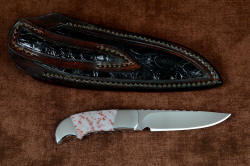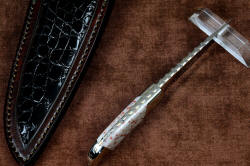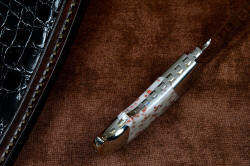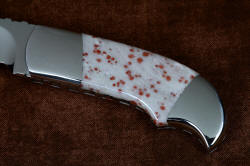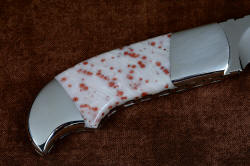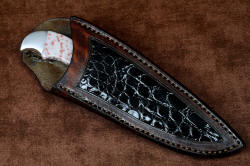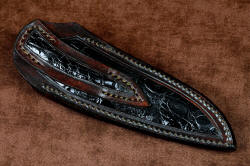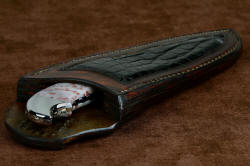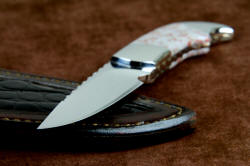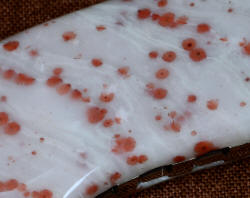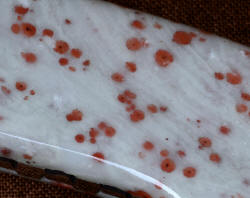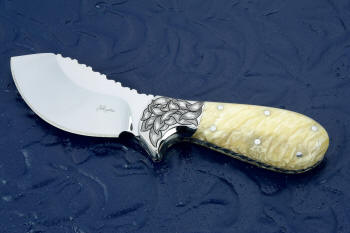Lacerta
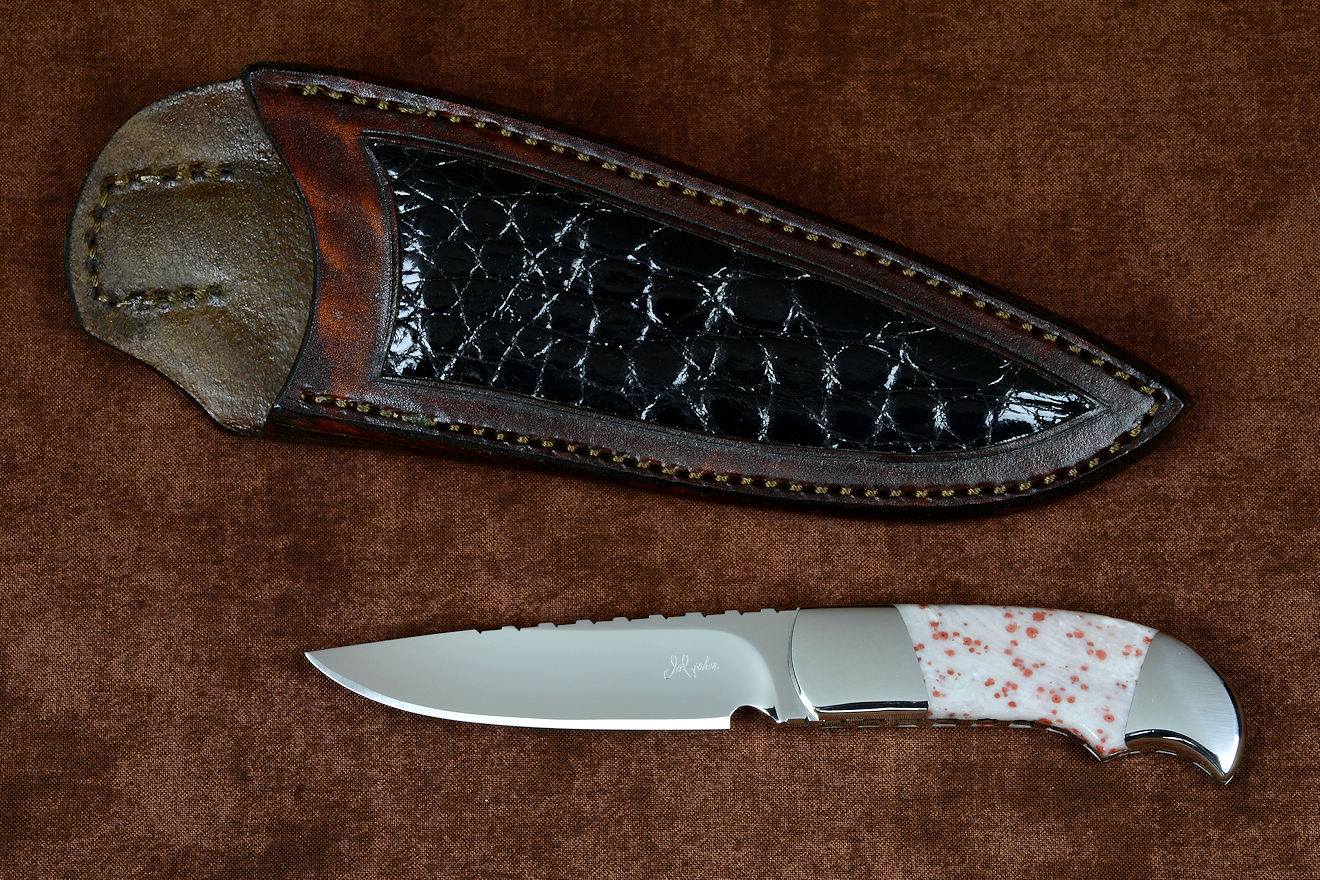
"Lacerta" Fine Handmade Knife
- Size: Length overall: 7.0" (17.8 cm), Blade Length: 3.6" (9.1 cm), Thickness: .200" (5.1 mm)
- Weight: Knife: 5.3 oz. (150 grams) Sheath: 4.4 oz. (112 grams)
- Blade: CPM154CM High Molybdenum Powder Metal Technology Stainless Steel,
Cryogenically Treated, Hardened and Tempered to Rockwell HRC 60.5, Mirror Polished
- Bolsters, Fittings: 304 Austenitic Stainless Steel, Mirror polished
- Handle: Red Freckled Dolomite Gemstone (Brazil)
- Sheath: Hand-carved Leather Shoulder inlaid with Black Glazed Caiman skin
- Knife: This is a small, lightweight, compact
knife that is extremely tough and durable. It's straight and
forward, and its name comes from the constellation Lacerta (the
lizard) which is also rather straight and forward! If you use
your imagination, you might visualize the lizard's small head at the
drop in the butt of the handle at the rear bolster...
The design is a great one recognizable as a working utility knife, a
small game knife, or even a table or steak knife for the ability to
use it in fine control. Of course, many of my knives are suitable
for collection, but they are serious working tools!
- The steel type I used in this Lacerta is CPM 154CM, a powder
metal technology tool steel. It's high in carbon, high in
molybdenum, and high in chromium, and with the deep cryogenic
and multi-tempering process I used for this knife, it has
extremely high wear resistance and toughness with fine carbide
development and uniform element distribution typical of powder
metal technology blades. The mirror polish on the steel is
gorgeous, also normal for these hypereutectoid high alloy
specialty steels.
- The blade shape is a slight drop point; the spine drops in
an even curve from the front bolster area to the tip, making the
knife strong and easy to sheath. The grind geometry is hollow,
for a thin, yet stout cutting edge and thick, sturdy spine. The
full tang is tapered for balance, and the entire tang and spine
are fileworked with a geometric, parallelogram design for
handmade distinction and improved grip.
- The knife is bolstered with zero-care 304 high chromium, high
nickel stainless steel bolsters, which are contoured, rounded and
polished for a comfortable feel. The bolsters are secured
with zero-clearance peened pins and dovetailed to bed the
scales.
- The handle scales are dolomite, mined in Brazil. This is a
beautiful gemstone, a calcite-based rock that has inclusions of
quartz and iron-based minerals. The white matrix has flowing,
streaming milky lines, with some areas of near-transparency. The
obvious appearance of the freckles is the distinguishing
characteristic, indicating high iron-based mineral content. In
magnification (see below), you can tell that the red areas are
inclusions of rock that seem to have bled a bit into their
surroundings. I'm always fascinated by the mineralogical and
geological context of the creation of stones like this; one of
the wonderful parts of making gemstone-handled knives.
- The shape of the handle is unique and different.
The front bolster is non-typical, as there is no forefinger
groove or front quillon on this design. This is because it's a
small knife, not expected to be used in fierce, forceful
applications, but designed to be used in highly controlled
applications of fine cutting. The flat area then accommodates a
wide variety of grip positions, and one of the most comfortable
is with the forefinger on top of the spine, and the middle
finger and thumb pinching the front bolster surfaces like a steak knife grip. The
rear of the handle or butt area is reinforced by a stainless
steel bolster, and has a finger groove and a peak for control by
the ring finger, or the little finger if using a steak knife grip.
The dropped shape at the butt means the handle is fully wrapped
in the palm of the hand.
- Sheath: I wanted a sheath to match the Lacerta,
but didn't want it to compete with the dolomite, so I made a
full-paneled inlay sheath more subdued and classical. I chose inlays
of Caiman, an alligatorid crocodilian, in black glazed
finish. These beautiful inlays are on the front, back, and even in
the belt loop of this deep and protective sheath. The leather is
9-10 oz. shoulder, dyed a medium brown for contrast. The sheath is
stitched with nylon and sealed with lacquer.
- A very nice smaller knife for fine control, with striking
gemstone and high alloy powder metal stainless steel blade.
Thanks, W. X.!
Hi Jay,
I got the Lacerta today!
Like I said, I've been following you for over ten years. I saw many of your photos and I enjoyed a lot looking at them.
But these are no comparable to truly hold one of your fine knives at hand.
This is the first time I order knife from you. Lacerta is the nicest knife that I have ever held. It allows me to really appreciate
your incredible craftsmanship.
Thanks a lot! It is my privilege and honor to own this knife.
You'll hear from me soon.
Best,
W.
Please click on thumbnail knife photos
